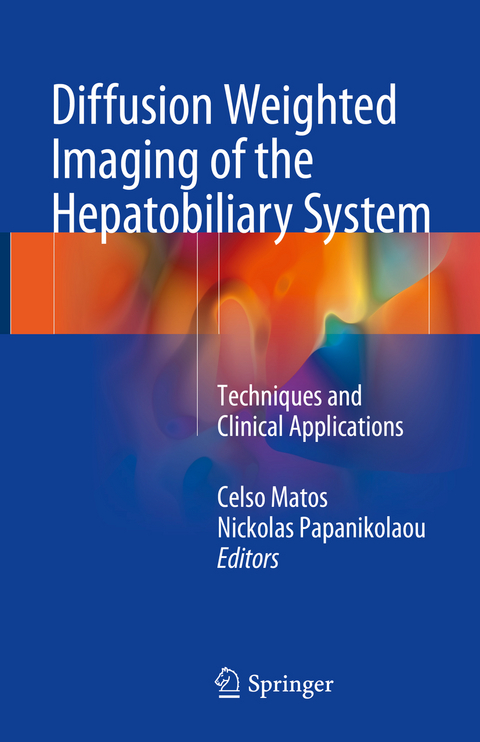
Diffusion Weighted Imaging of the Hepatobiliary System
Springer International Publishing (Verlag)
978-3-319-62976-6 (ISBN)
This book presents the core principles and technical aspects of Diffusion Weighted Imaging (DWI), as well as pearls and pitfalls concerning the imaging technique's application to the hepatobiliary system. All technical aspects and clinical applications discussed focus on the related anatomical region and its pathologies.
Given that magnetic resonance physics is complex and can be cumbersome to learn, the volume editors and authors have made it as simple and practical as possible. Accordingly, tables related to technical details (imaging protocols, artefacts, and optimization techniques) are provided for each chapter.
Though DWI is frequently used in the abdomen and pelvis, its clinical role is still evolving, especially for the diagnostic workup of oncologic patients. Although certain efforts have been undertaken to standardize and provide imaging guidelines for different clinical indications, the standardisation and clinical validation of quantitative DWI-related biomarkers are still works in progress.
Addressing this gap, the book offers a useful tool for radiologists with a particular interest in abdominal radiology, as well as for radiology residents.
Celso Matos studied medicine at the Medical School of the University of Brussels, Belgium and obtained his Medical Degree Magna Cum Laude in 1980. Following a residency in Internal Medicine and Rheumatology at the University of Brussels, he started his residency in Radiology at the department of radiology at Erasme University Hospital in Brussels. As a board-certified radiologist he would later join the faculty of this department and lead the MR imaging division, becoming a professor of clinical radiology in 2001. In late 2015 Celso Matos moved to Lisbon to take on his current position as chair of the imaging department at Champalimaud Center for the Unknown. He currently serves as President of ESGAR, and is engaged in ESOR activities as a member of the ESOR steering committee. Through these commitments he is also actively involved in clinical societies and acts as a liaison between the world of radiologists and the world of clinicians. As a radiologist he contributes to the imaging program in several annual meetings and regularly co-organizes radiological-clinical educational events. His main focus is on multidisciplinary research in pancreatic cancer and related disorders and the validation of MR imaging biomarkers for predicting response to cancer treatment. For his scientific work Celso Matos has received awards from his peers including the European Radiology 2006 best scientific publication. He has (co)authored over 100 papers and authored over 10 book chapters. He has been part of the Abdominal Section of the European Radiology Editorial Board since 2014 and acts as peer-reviewer for several journals including European Radiology, Radiology (awarded as a distinguished reviewer 5 times), AJR, and Gut. He has delivered over 300 invited lectures at radiological and clinical society meetings around the world and received the European School of Radiology Best Teacher Award in 2014. Nikolaos Papanikolaou is a Principal Investigator for Oncologic Imaging at Champalimaud Foundation in Lisbon, and an affiliated researcher of the Karolinska Institute in Stockholm. He received his Ph.D. in Medicine from the University of Crete, Greece. Dr. Papanikolaou has published 54 papers in international peer reviewed journals, 17 book chapters, and held 72 invited lectures for international congresses and educational courses. He is an honorary member of SEDIA and a fellow member of ESGAR. His main research focus is on Diffusion Weighted Imaging, modelling, post processing and clinical applications in the body area.
Techniques, Protocols and Post Processing Aspects.- Benign Liver Lesions.- Malignant Liver Lesions.- Diffuse Liver Disease.- Malignant Bile ducts stricture.- Benign Bile ducts stricture.- Pancreatic Inflammation.- Pancreatic Solid Neoplasms.- Pancreatic Cystic Neoplasms.
| Erscheinungsdatum | 29.10.2020 |
|---|---|
| Zusatzinfo | V, 145 p. 67 illus., 23 illus. in color. |
| Verlagsort | Cham |
| Sprache | englisch |
| Maße | 155 x 235 mm |
| Gewicht | 384 g |
| Themenwelt | Medizin / Pharmazie ► Medizinische Fachgebiete ► Onkologie |
| Medizinische Fachgebiete ► Radiologie / Bildgebende Verfahren ► Radiologie | |
| Medizin / Pharmazie ► Physiotherapie / Ergotherapie ► Orthopädie | |
| Technik ► Umwelttechnik / Biotechnologie | |
| Schlagworte | biomedical engineering • Biomedical Engineering/Biotechnology • diffusion weighted imaging • Imaging / Radiology • Liver Cancer • Magnetic Resonance Imaging • Medical Imaging • Medicine • Medicine: general issues • Oncologic Imaging • Oncology • Radiology • Treatment Response |
| ISBN-10 | 3-319-62976-X / 331962976X |
| ISBN-13 | 978-3-319-62976-6 / 9783319629766 |
| Zustand | Neuware |
| Haben Sie eine Frage zum Produkt? |
aus dem Bereich


